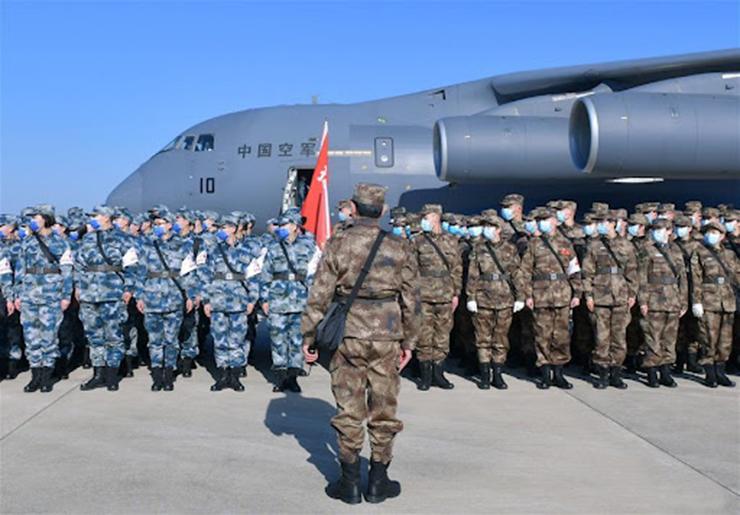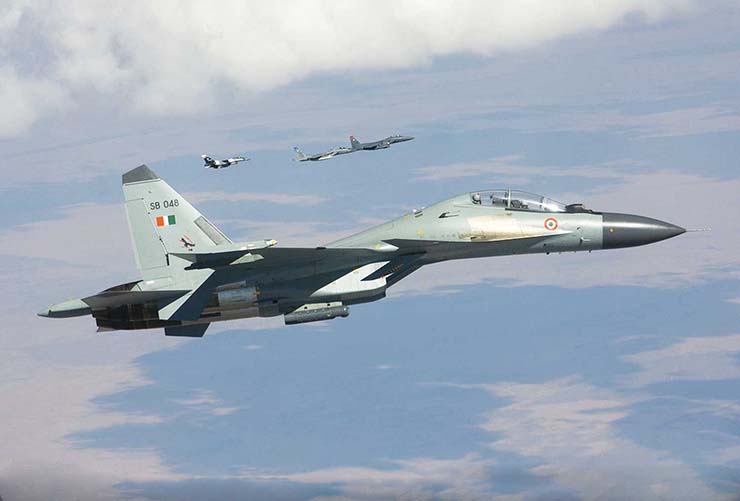
The Indian Air force (IAF) is undergoing a phase of rapid modernization more so due to the ongoing India-China faceoff. Air-power would be the most important factor in any scenario especially against China, as the harsh terrain of Himalayas and natural geographical advantage towards India make air-power a game-changing force.
The IAF is indeed one of the most powerful and professional armed wings in south Asia and the world, but the Chinese People’s Liberation Army Air Force (PLAAF) is also taking quantum leaps in the industrial sectors that can’t be ignored. The IAF is also way short of its desired fighter squadron strength while the PLAAF already enjoys numerical superiority which is likely to be more in future because of the rapidly increasing production rates of the Chinese aircraft industry.
Why numbers matter?
Numerical superiority has always being a decisive factor in aerial combat. A report published by the Manohar Parrikar Institute for Defense Studies and Analysis, says: “Two forces equal in number and reasonably close in equipment and skill have tended to have equal losses in combat. On the other hand, whenever the numbers ratio has become more favorable to one side, its losses as well as loss percentages have fallen disproportionately, with opposite effect on less numerical party. Thus, technology and skills irrespective, numbers do matter in aerial combat. The slogan of ‘fighting outnumbered and winning’ has no place at operational level of war unless a very large technological asymmetry exists.”
The report further gives the example of F-35 ‘Lightning’ with the United States Air Force (USAF) and how the US still plans to maintain numerical superiority by acquiring such technologically advanced aircraft in large numbers even when it doesn’t have any high-tech enemy since the demise of the Soviet Union.
Is the requirement of 42 combat squadrons exaggerated?
The IAF has a sanctioned strength of 42 combat squadrons. Many experts argue that the number is an ‘exaggeration’ because it was given at a time when the IAF had many 3rd generation aircraft that were only capable of performing mission-oriented tasks and were meant to be operated in large numbers unlike modern-day 4th generation aircraft that are technologically superior, can perform multi-role tasks and need not to be operated in such a large numbers.
However, it should be understood that India is an emerging power and its interests lie beyond its territories even as its adversaries are already planning to significantly boost their airpower.
The PLAAF is already the world’s 3rd largest air force with over 2,000 combat aircraft that include aircraft for different purposes varying from stealth to multi-role 4th generation aircraft, and adding to the complexity, Pakistan is also planning to acquire 614 combat aircraft with multiple AWAC and mid-air refuellers in future.

Hence the need of 42 combat squadrons seems justified for a two-front war as indicated by former Chief of Air Staff BS Dhanoa in an interview: “There is a misconception that IAF does not need 42 squadrons. We have government sanction; we have policy pages of 42 squadrons with us. If you say Su-30 has come and it is as much more effective as MiG-21, why did you need so many? It is very good provided the other side (China/ Pakistan) stays on the first and second generation aircraft. When they go to 4th generation aircraft then we need 4th generation aircraft to counter-attack. You are not fighting against vacuum. You are fighting against somebody. So, 42 squadrons are required to carry full spectrum of war in all contingencies. The keyword is full spectrum of operations. It’s not that you cannot fight. Even if you have low number of squadrons you can always do air defence duties. This is what the Vietnamese did against the Americans in the war”.
How can IAF achieve sanctioned squadron strength?
The options in front of the IAF to achieve the desired strength of 42 fighter squadrons are:
- Current acquisition process
- Pursuing self-reliance
- Foreign imports
Current Acquistion Process
It is observed that recently the IAF is engaged in signing deals that were previously struck for years. The IAF is now looking forward for quick development of indigenous aircraft like the Advanced Medium Combat Aircraft (AMCA) and Tejas MK-2 to modernize its fleet and replace a large number of ageing aircraft like MiG-21s and Darin Jaguars.
The IAF in a span of just five years signed deals for almost 150 aircraft and also cleared some of the most important deals like that of 83 Tejas MK-1A and 36 Dassault Rafale that will significantly boost IAF’s capability and help in the modernization.
However, the current trend of aircraft procurement can just help IAF maintain a minimum number of quality aircraft without giving any special boost to its strength significantly. It is expected that the IAF under the current acquisition process may order another tranche of 36 Dassault Rafale F4 which would take the operational combat squadrons to 30.
The MiG-21, on the other hand, presents a serious challenge for the IAF as the aircraft is on the brink of being retired because of its age and high crash rates but is still being used by IAF because of its strength of six squadrons, a number the IAF can’t compensate as of now.
The MiG-21 is planned to be replaced by 83 Tejas MK-1A, production of which will start from 2023 at a rate of 16 aircraft per annum. The expected delivery of all units would be completed by 2028 excluding delays which would again push the Bisons beyond their timeline.
Pursuing Self-Reliance
The IAF is actively participating in the ‘Aatmanirbhar Bharat’ programme, in fact, the deal of 83 indigenous Tejas MK-1A is one of the largest deals towards indigenous products ever inked by any wing of the Indian armed forces. The IAF can choose to go the indigenous way to fulfill its requirement of feasible modern-day combat aircraft.
DPSUs like ADA and DRDO along with other private companies are actively developing indigenous aircraft like Tejas MK-2 and AMCA, both of which would be extremely beneficial for the IAF. The Tejas MK-2 is going to be a necessity for the IAF in future because of its advanced 4.5th generation capabilities combined with the feasibility of a single-engine aircraft, while AMCA will provide IAF a technological leap over its adversaries because of its advanced ‘5.5th generation stealthy capabilities’.
The Tejas MK-2 becomes more important as it would play the role of a test bed for the multiple technologies of AMCA and is meant to replace the multiple mission-oriented aircraft like Darin Jaguars and MiG-29s.

The IAF can go the indigenous way to fulfill its future requirement of extremely advanced combat aircraft. The indigenous aircraft would offer some unique benefits like:
- The aircraft will be designed especially to meet the requirements of end-users like the IAF and hence would not be expected to have problems that are currently faced with other aircraft in terms of maintenance, feasibility and capability.
- If indigenous aircraft are accepted as standard choice for IAF, then they would significantly boost the private aircraft manufacturing sector, would ensure logistical availability, fleet uniformity and would provide technological superiority.
- The potential of such futuristic indigenous aircraft combined with Indian diplomacy can significantly boost Indian exports and diplomatic relations in future.
However, the government, along with concerned organizations, need to change the aircraft designing and manufacturing process in the country as delays have become an integral part of the system. The delay in production is a huge setback for the IAF. It is one of the most important reasons why the IAF, like other wings of armed forces, still shows reluctance towards indigenous products and have been more dependent on imports from other nations to fulfill its requirements.
Despite all this, the IAF has promised very large orders of indigenous aircraft like Tejas MK-2 and AMCA in the range of about 200 and 100 units respectively which would help to achieve its sanctioned strength.
Foreign Imports
If the shortcomings that are currently found in Indian aerospace sector are not rectified in time then the IAF would be compelled to go in for foreign aircraft. The idea of importing weapons may seem like a perfect one but it’s a matter of fact that the Indian armed forces are facing severe consequences of importing weapons. The imported weapons and systems do give a wide range of choices and may even offer regional technological superiority, but imports have a wide range of drawbacks like:
- The host nation may supply weapon and systems to enemy forces to maintain diplomatic ties. The French Dassault Mirage with Pakistan or the Russian Su-30 MKK with China are good examples.
- Strained diplomatic relations with the host nation would eventually lead to grounding of imported aerial assets like the case of US-made F-16s with Pakistan under Trump administration or how France refused to provide support package to the Pakistani Mirage-2000s.
- It is observed that the Indian armed forces are not free to import according to their requirements. Rather the geo-politics and the role of the import lobby play a major role as exemplified by the dominance of Russian equipment with the Indian armed forces.
- The imported weapons are usually more expensive and are always a level low in quality than the ones operated by host nations.
- The cost increases exponentially during the import process. The Dassault Rafale ultimately cost a humungous $200 million against initial offered paper price of $120 million.
- Due to high cost, achieving numerical superiority only with imported assets is quite difficult.
- The import lobby combined with weak leadership will eventually adversely affect private in-house production as in case of India where private companies were hesitating to invest huge sums in the defence sector.
Hence, imports come with a series of drawbacks that are not visible on paper. The strong presence of the import lobby In India has already made the nation suffer adversely in development of some critical technologies. The current leadership at IAF and the central government has diluted the power of the import lobby in the nation, however it is still observed that in many cases the armed forces do prefer foreign options over even better indigenous alternatives.
Ideal Approach for IAF
“The IAF will have around 37-38 fighter squadrons in a decade”, said Deputy IAF Chief Air Marshal Sandeep Singh. It is further expected that indigenous products will become a standard choice for the IAF as it would be very difficult for IAF under current monetary situations to order 200 units of any imported asset against 200 units of Tejas MK-2 because of the feasibility and efficiency of indigenous products.
The IAF currently is planning to sign a deal for a new batch of 36 Dassault Rafale F4 and push the number of overall operational combat squadrons to 30. But the retirement of MiG-21s is being planned in a phased manner and their replacement with Tejas MK-1A will begin from 2023. The operational fighter squadron strength is expected to be slightly over 30 even after deliveries of all unit of Tejas MK-1A as their numbers would be offset by retirement of MiG-21 Bisons.
The IAF would then look forward for rapid development of Tejas MK-2 and AMCA which is expected to be completed by 2030 and 2035 respectively. The IAF would then place order of these aircraft in big numbers to the tune of 200 units or 10 squadrons of Tejas MK-2 and five initial squadrons of AMCA MK-1 that would take the total operational combat strength to over 45 fighter squadrons. This would not affect capabilities even if other aircraft like MiG-29s and Darin Jaguars retire by then.
-The writer has keen interest in defence platforms and enjoys doing technical analysis and detailed comparison of defence equipment. Views expressed are personal and do not necessarily reflect the views of Raksha Anirveda








